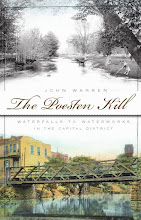On the Hudson River along upstate New York’s eastern border within the natural boundaries of river and mountains lies the rough rectangle of Rensselaer County. It is literally cut in half by the Poesten Kill, a powerful stream that scours its way downhill from 1,600 feet in the Petersburg Mountains to the sea level flats of the Hudson River. The Poesten Kill splits the county across the middle into two pieces of roughly equal size, north and south. It tumbles off the mountains and meanders across a ten-mile wide plateau and then falls abruptly through a series of steep gorges to settle into the Hudson River floodplain. Although frequently hidden now behind modern development and historic ruins, the Poesten Kill’s geologic wonders are impressive. As it descends, the kill cuts through layers of rocks, shales, and silts and emerges from forested mountains, winds through rolling farmland, falls over steep cliffs and slides into the tidal Hudson. There are five major natural waterfalls on the Poesten Kill. They include Poesten Kill High Falls (Mount Ida Falls) in Troy, Barberville Falls in east of Poestenkill Village, and three falls in the Town of Brunswick: the falls at Eagle Mills, Fred's Falls in Cropseyville (on the Poesten Kill’s largest tributary, the Quacken Kill), and Buttermilk Falls.
Although frequently hidden now behind modern development and historic ruins, the Poesten Kill’s geologic wonders are impressive. As it descends, the kill cuts through layers of rocks, shales, and silts and emerges from forested mountains, winds through rolling farmland, falls over steep cliffs and slides into the tidal Hudson. There are five major natural waterfalls on the Poesten Kill. They include Poesten Kill High Falls (Mount Ida Falls) in Troy, Barberville Falls in east of Poestenkill Village, and three falls in the Town of Brunswick: the falls at Eagle Mills, Fred's Falls in Cropseyville (on the Poesten Kill’s largest tributary, the Quacken Kill), and Buttermilk Falls.
The Poesten Kill has been home to American Indians who hunted, gathered, fished and farmed along its shores, frontier Dutch farmers and traders, colonial tradesmen, merchants, millers, and lumbermen, and nineteenth century iron, steel, textile, and paper workers. Dutch, English, Irish, German, French, Italian, immigrants and others have lived along its length. Its mouth at the Hudson was the first truly European frontier settlement beyond the walls of Fort Orange (what is now Albany).
So the Poesten Kill was a frontier outpost that seemingly had it all: a large flat farmable flood plain, a potent source of water power, and it also had room to grow. From the mouth of the Poesten Kill, Manhattan Island, the Atlantic seaboard, Lake Champlain, Montreal, the St. Lawrence River, the Mohawk River, the Great Lakes, the Hoosac River and New England were all within reach – even in prehistoric times. The markets at Albany, New York, and later Troy in particular, are crucial to understanding the development along the Poesten Kill.
The force of the water in the Poesten Kill helped drive the early development of Troy, once one of America’s most important nineteenth century industrial cities. The Poesten Kill’s waters were harnessed for the American industrial revolution that built the golden age of American industry, trade, and commerce; its banks afterward stood witness to industrial abandonment and urban decline.
Mills established along the Poesten and Quacken kills sent their goods, mostly grain, farm produce, wool, cotton, and iron products, but also a variety of other consumer goods, to the markets at Troy and beyond. For instance, in the 1870s Poestenkill Village was home to saw and grist mills, a cotton batten factory, a flax mill, and a shirt factory. At the same time mills along the Quacken Kill produced twine and carpet warp, paper, brush handles, cotton batten, carded and fulled wool, including cashmere, flannel, and yarn. At Eagle Mills there were saw and grist mills, two iron foundries producing hoes and other farm tools, and nearby, three shirt factories.
At the head of Hudson River navigation the mouth of the Poesten Kill was located at the eastern end of the Erie Canal, the southern end of the Champlain canal, and an important center of the very early Rensselaer & Saratoga and later Troy & Greenbush and New York Central railroads. The Poesten Kill was home to the first paper factory in Northern New York and for many years Troy rivaled Pittsburgh in iron and steel production. What really made life along the Poesten Kill so unique, however, was the diversity of products made there. Unlike other eastern urban areas, the Poesten Kill was home to producers of agriculture and forest products along with feed, flour, paper, plaster, paint, textiles, iron and steel products like stoves, valves, and wire – a substantial variety of consumer goods used along the kill and in the world beyond.
The Poesten Kill, will be published by The History Press this Spring. I'll be posting plenty of additional material here that didn't make the book, along with images, maps, and more. You can sign up to get the RSS Feed or get the posts by e-mail by entering your email address at right.
Until The Poesten Kill is available, pick up a copy of Don Rittner's new book Remembering Troy: Heritage on the Hudson.
Wednesday, January 28, 2009
A New Book About The Poesten Kill
Subscribe to:
Post Comments (Atom)

No comments:
Post a Comment